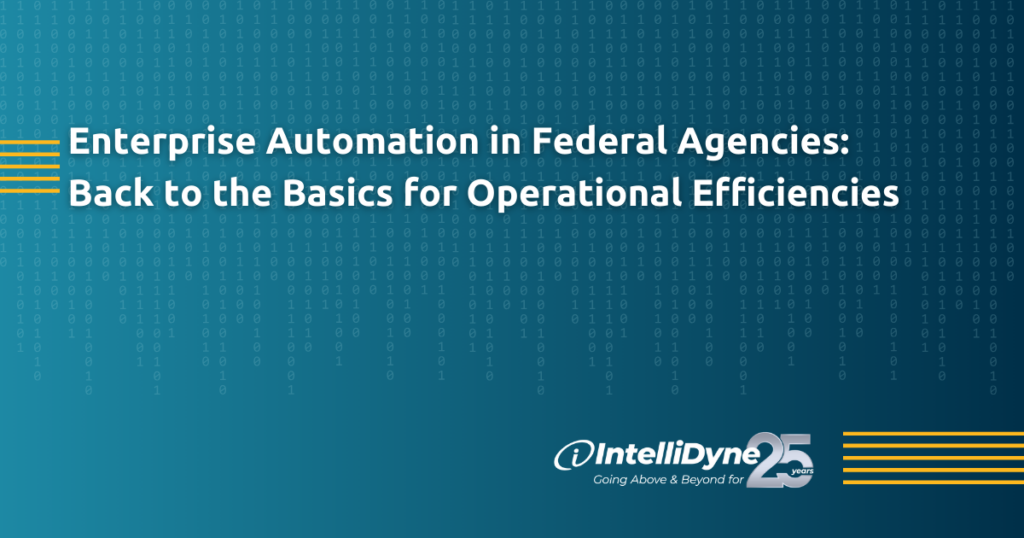In the last 25 years, IntelliDyne has witnessed many advances in automation in the federal marketplace. While many agencies have matured their automation efforts and are now focused on applying sophisticated intelligent automation (IA), the backbone of any automation platform is the operational shift from manual tasks to the simplest forms of process automation.
Workflow Automation 101
One of the most common and impactful examples of the benefits of automation is network service outage notifications. The process in handing an outage can be slow and laborious, relying on a rudimentary trigger in an event log at the engineer level or end user to submit a support ticket.
In either case, IT cannot be proactive. Gauging the breadth of the disruption to productivity becomes a time-consuming game of cat and mouse as IT follows a trail to troubleshoot the issue, all the while facing service level agreements (SLAs) requiring stakeholder communication at various levels in the organization. Maintaining SLA notifications, while essential, distracts from researching and remedying the incident and can easily amount to an hour or more of work across multiple resources.
An automated workflow streamlines both the communication and resolution process when time is of the essence. In less than ten seconds, the surge team can be notified of an incident, while automated notifications inform key stakeholders via email and text message with status updates at pre-determined intervals from initiation to closure—all without any manual intervention. Not only does this improve your vendor or IT department’s SLAs, but it allows key resources to focus on timely resolution.
Four IT Challenges Faced by Federal Agencies Today
At the heart of any automation effort should be the conversion of simple task execution, the low-hanging fruit that provides the most immediate benefit. And yet as commonplace as this type of automation has become, some agencies still struggle with basic workflow automation. Every day new pain points arise on the path to maturing any new technology, particularly now that we are in the middle of a federal IT modernization effort. Some roadblocks evolve out of the application and support of new technologies themselves while others are inherent in the operations of the federal government, such as budget constraints and historic underfunding of IT.
- Closing Skill Gaps: The pace at which technology continues to change is creating a struggle for federal agencies to find and retain skilled IT professionals. The demand for specialized skill sets in cyber, cloud, AI, and data analytics will continue to outpace the available talent pool in the market. The inability for an agency to close the skill gap will lead to delays in implementing new technologies, maintaining system security, and effectively managing IT infrastructure and environments.
- Modernizing on Modest Budgets: Federal agencies are continuing to modernize their digital services to deliver high-quality experiences to stakeholders/partners and citizens, as well as modernizing their workforce experience to support remote work and evolve their strategy for mission continuity. However, the complexity these efforts introduce can drive up operational expenses and create strain on limited budgets.
- Moving to a Multi- or Hybrid-Cloud Model: The adoption of the cloud introduces new challenges for federal agencies’ IT shops. These challenges include managing and integrating legacy and modern systems while navigating the complexities of transitioning to a multi-cloud or hybrid cloud operations model. As federal agencies transition to one of these new models, they must consider the challenges introduced by resource costs, scalability, compliance, and security risks, and how best to manage and configure hybrid infrastructure. Federal agencies must leverage automation and orchestration functions to streamline hybrid cloud operations, ensure smooth transitions, optimize resource management, and drive improvement for overall performance.
- Creating a Self-Healing Network: Many IT organizations aspire to develop networks capable of detecting and resolving issues automatically. A network that can proactively spot and fix disruptions, security threats, and performance issues would greatly minimize downtime and boost efficiency. However, creating such a self-healing network demands sophisticated automation and orchestration. This involves integrating advanced technologies like artificial intelligence, machine learning, and analytics into the automation framework to enable predictive maintenance, anomaly detection, and autonomous recovery processes.
IntelliDyne’s Enterprise Automation Framework: Matching Your Maturity
IntelliDyne meets agencies where they are in their automation journey with a flexible, adaptive framework for automation transformation. Sometimes we start at square one, when an agency needs to stop the bleeding or get out of reactionary mode. With maturity, automation can go from workflow-driven to predictive, anticipating a problem based on certain indicators too subtle to detect manually across an entire network. Once we identify workflows to automate, our end-to-end framework empowers agencies to design, implement, and measure automation success. By enabling operational efficiencies—moving from reactive to proactive and, ultimately, to predictive—agencies can not only perform smarter and faster but foster an environment of innovation and modernization to stay ahead of the curve. Contact us to learn more.

